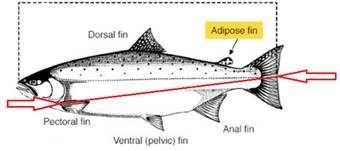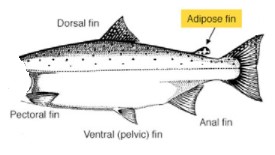

Fishers are reminded that they may not retain or transport more than their individual Possession Limit for any species, nor more than any aggregate limit.
The following requirements apply until a fish is prepared for immediate consumption, or the fisher arrives at home, or the fisher delivers their fish to a registered processing service.
If you clean or package your fish, note that regulations require that the species, number, and size of the fish can be readily determined to make sure your catch complies with Daily and Possession Limits, including size and mark specific regulations. For all salmon species, never remove the skin.
If filleted, one complete/intact fillet from one side of the fish including the pectoral fin and the tail fin must be retained. In addition, for Chinook and Coho, the adipose fin or the healed scar showing the hatchery mark must be retained on the same fillet. (See diagram under General Reminders tab.)
When packaging your salmon catch, heads may be removed per the following requirements:
For all salmon species:
For Chinook and Coho, additionally:
If necessary the other fillet can be cut into two pieces. All the fillets should be placed side by side in one bag making it obvious that they represent one fish, and the bag must be clearly labelled with:

One fillet must retain the Pectoral fin and tail fin.
For hatchery Chinook and Coho, there will be a healed scar in place of the Adipose fin – this must be retained on the fillet with the Pectoral fin and tail fin.
Missing adipose fin? Submit the head for Salmon Science.
Fishers are encouraged to participate in the Salmon Head Recovery Program (1-866-483-9994) by labeling and submitting heads from hatchery-marked Chinook and Coho to Head Depots. You will be contributing necessary information for stock assessment and management decisions to protect stocks at risk and guide sustainable fisheries along the west coast of Canada and USA.
Head-off length equivalents support participation. Fishers are required to leave the portion of the fish that contains the pectoral fin and the tail fin intact. The head-off pectoral fin to tail measurement will be used by enforcement officers to assess compliance to minimum or maximum sizes if you remove the head from Chinook or Coho.
When steaking a salmon, leave the steaks connected by a piece of skin; in addition, the tail must remain connected to the skin.
When packaging salmon for guests, lodges and charter operations are to clearly provide the following information on the outside of the transport box.
When individuals are transporting or shipping fish they must package their fish separately and only have one name per package. However, they may share a container. It is recommended that the contents (number of fish, species, and number of packages) be listed on the outside of the container to facilitate inspection.
It is recommended that you store and transport your catch in sanitized containers and packages intended for food.
Salmon Head Recovery
If you catch a "marked" fish - one with a healed scar in place of the adipose fin (coho or chinook), remove the head and submit it to a Salmon Head Recovery Depot, with a completed sport head label (available at the Depot). Once the head is dissected you will receive information about your catch.
Contact the Salmon Head Recovery Program at 1-866-483-9994 for more information.
By participating in the Salmon Head Recovery Program, you will be contributing necessary information to allow for continued sport fishing opportunities.
In some cases, certain hatchery stocks are used to indicate the health of other stocks in the area. Tag recoveries not only help to indicate that stocks are healthy, but also that stocks of concern could be improving.
In addition to marking hatchery salmon, a very small number of wild coho and chinook (less then 5%) are also tagged and adipose clipped to help biologists monitor habitat enhancement projects associated with wild salmon stocks.
It is just as important to turn in heads from terminal or freshwater sites as it is from marine areas. Even though anglers fishing close to hatcheries can be fairly certain of the origin of their catch, data will not be recorded unless the heads from fin-clipped recoveries are turned in. Without the data, the health of the stock and the value of the resource to anglers could be underestimated.
We use tagging programs in BC to study the migration and growth of salmon. This involves attaching numbered tags to fish, usually located near the dorsal fin.
The two kinds of external tags you might encounter are:
Report: If you discover an external tag on your catch, report the number along with information on where the fish was caught to your nearest DFO office, or mail it to: Erik Grundmann, Pacific Biological Station, 3190 Hammond Bay Road, Nanaimo, B.C. V9T 6N7.
Should you find a PIT tag, turn it into your local Fisheries and Oceans office and include details of where and when the fish containing the tag was caught.
Atlantic Salmon Watch Program
The Atlantic Salmon Watch Program (ASWP) is a research program operated by Fisheries and Oceans Canada. The purpose of the program is to study the abundance, distribution and biology of Atlantic salmon in British Columbia and its adjacent waters. The ASWP monitors reports from commercial and sport catches and observations of Atlantic salmon throughout British Columbia. The program relies on recreational and commercial fishers, fish processors, government and independent field staff and hatchery workers to report observations of Atlantic salmon.
Click thumbnail to enlarge image.
Keep the fish and report the capture by calling the ASWP toll-free reporting line at 1-800-811-6010. You will be asked where and when you caught the fish and if you wish to donate the fish or part of it for research purposes. Donation is not mandatory but it does provide valuable samples for our scientific study. For whole fish donation, the entire fish, including entrails, should be frozen or kept on ice. Alternatively, the head and a small portion of the back including scales can be preserved. ASWP staff will arrange for transport of the sample.
Report all captures of Atlantic salmon to: 1-800-811-6010 (toll-free).